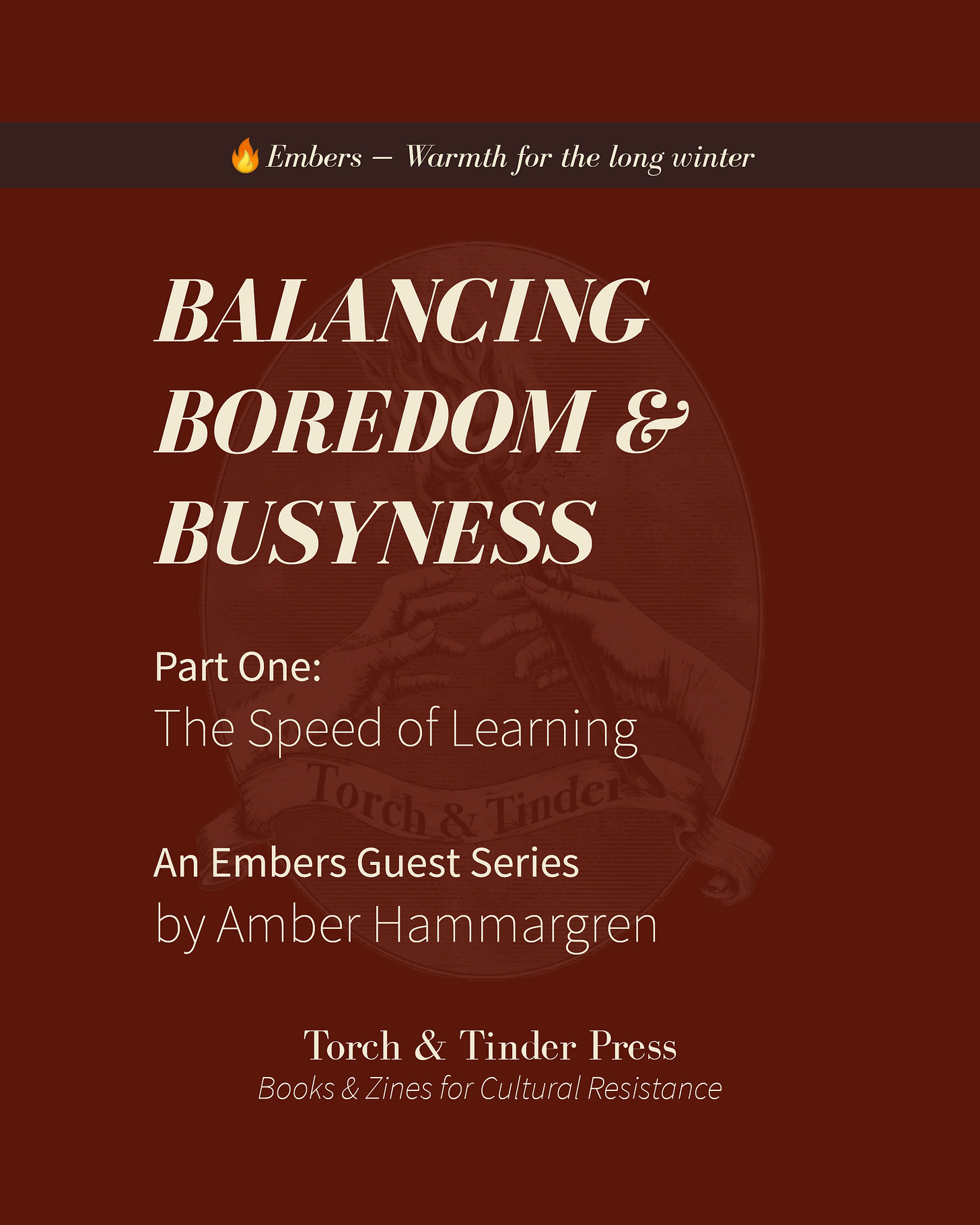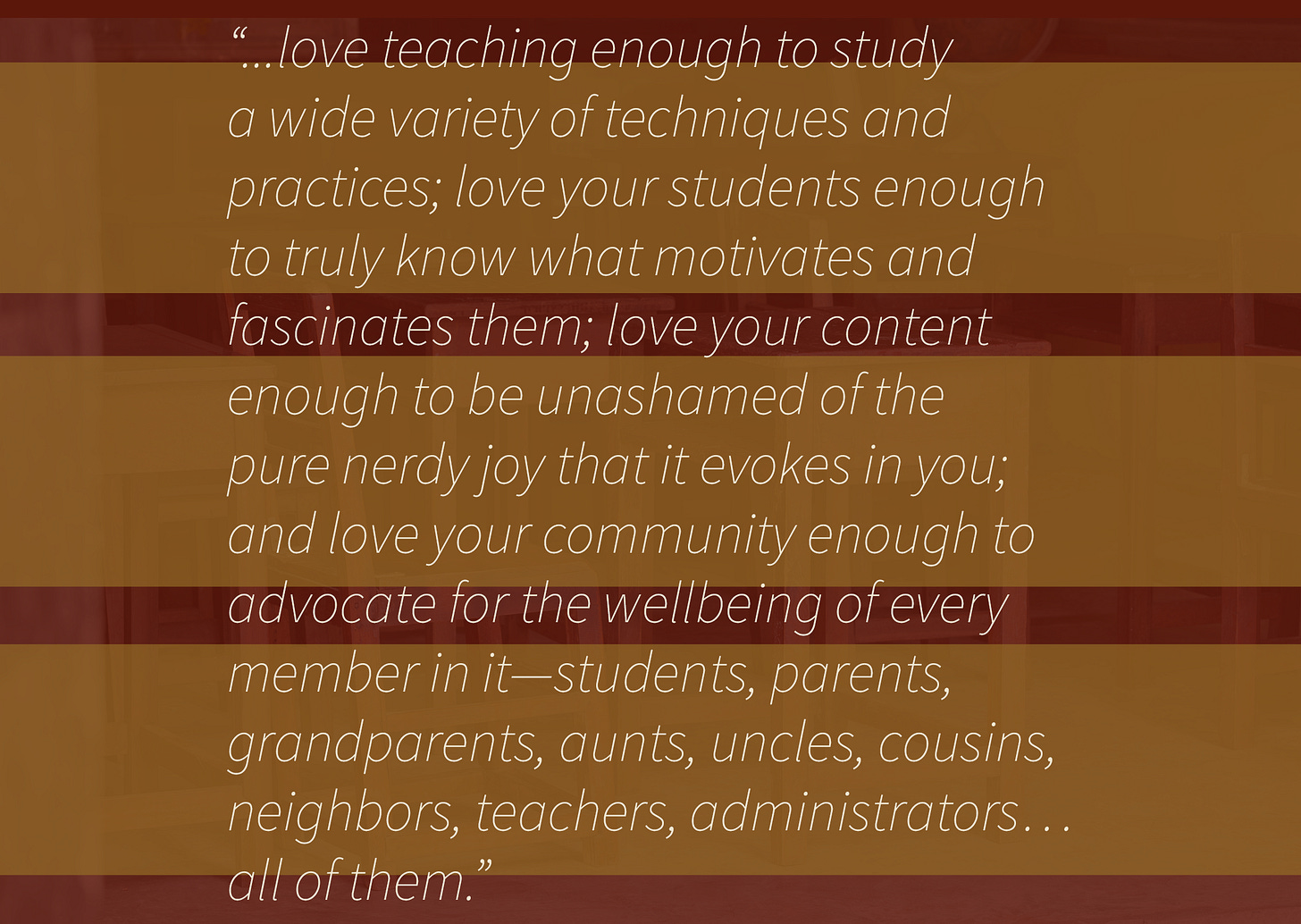Balancing Boredom & Busyness, Part One: The Speed of Learning
In a culture that measures growth in test scores and speed, Amber Hammargren reflects on what it means to learn and to teach at a human pace.
🔥 Embers — Warmth for the long winter
Every classroom lives between two fears: falling behind and standing still. In this opening essay from Balancing Boredom & Busyness, educator Amber Hammargren explores how real growth depends not on acceleration but on attention.
The speed of learning is something that is often a topic of concern in classrooms. Whether our students are “keeping up,” “meeting growth,” or “on grade level,” the idea that however fast they are learning, it never seems to be quite fast enough. It is something that is often a concern for students too, although for them it sounds different: whether they will feel bored or fascinated or lost. Students are often equally concerned with the pace of the content being too fast as they are with too slow.
The right materials, at the right time, at the right level of challenge, in the right environment… create a transformative magic, an alchemy that alters a student forever in all the best ways. An entire industry in the educational world is built around trying to package and sell it to communities who are desperate to feel like their schools and their students will experience more success if they only stick to a formula—that it will work for them all, make it easy and intuitive for both teachers and students, and that the students will suddenly learn faster.
There is a science to teaching and learning, and there are absolutely some techniques that have proven more effective than others. But there is no magic wand that will cause all the students in a classroom to be constantly engaged or to grow at the same rate, and it is a mistake to continue chasing after something that does not exist.
If anything can be said to come close, it is this: love teaching enough to study a wide variety of techniques and practices; love your students enough to truly know what motivates and fascinates them; love your content enough to be unashamed of the pure nerdy joy that it evokes in you; and love your community enough to advocate for the wellbeing of every member in it—students, parents, grandparents, aunts, uncles, cousins, neighbors, teachers, administrators… all of them. And when you do that, everyone wins. With all of those relationships and all of that knowledge, the Goldilocks zone for engaging students becomes easier to find consistently. It is unique to each learner, and even the same person will not present the same needs every day. The students will still not all learn at the same rate, but they will grow and learn… and so will you.
However, claiming that the real answer to sustainable learning growth is a combination of boundless curiosity, trust in teachers and students, and love of community… is not something that can be packaged and sold to state legislators and school districts, nor something that can be reduced to an easily replicable formula that is guaranteed in all situations. And until those who write educational policies accept that there is no magical perfect one-size-fits-all product that will effortlessly turn public schools into factories of compliant, literate test-taking machines in human form… schools will always be a failure by the metrics they set.
Of course, creating the narrative that “schools are failing” may just be their real goal.
This reflection opens Hammargren’s three-part Guest Series on pacing, mastery, and the art of going slow — continuing Monday in Embers.
Introducing The Capitalist-Industrialist Education Model
“Do more, do it faster, make them all the same...and laud it for its efficiency and consistency.”
How many of us have had the uniquely dissatisfying experience of sitting in a classroom or seminar where it felt like we were being fed the same fast-food sound bites of information we have been forced to endure repeatedly? The desperate wish cried out in our minds afflicted with boredom: could we please move on and go faster, and then not come back to this anymore? Both as a young student and in adult professional development sessions, I have experienced the terrible yearning to go faster and farther, or the freedom to escape from content and assignments that I found to be irrelevant or faulty (and not permitted to push back, to challenge the content, to ask critical questions). As I began my teaching career, I fervently pursued ideas for how to make it possible for more students to succeed quickly, so that fewer students would feel lost and fewer students would feel trapped in boredom. I pursued ideas for how students could retain their learning more effectively, requiring fewer repetitions for the knowledge and skills to “stick”. I wanted my students not to suffer in my classroom the twin feelings that lead to disengagement that I remembered so clearly from too many of my own student experiences: confusion and boredom. I did not realize it for many years, but I had fallen for the myth that learning more, and learning faster…was the epitome of achievement. When confronted by enforced learning sessions or tasks that I still find inane, it is very easy to seek efficiency as a goal. That if we must endure something unpleasant, then at least the pain can be minimized by making it take the least possible amount of precious time and energy.
There is nothing inherently wrong with a desire to learn efficiently, but without additional depth or purpose...we leave ourselves vulnerable to the trap of believing that more is always better…and to quote “Sabrina”, “more isn’t always better, sometimes it’s just more”. Without a destination that fills us with a sense of purpose, learning more content at a faster rate does not lead to a sense of accomplishment or satisfaction: it leads to disillusionment, discontent, disengagement, and burnout. Am I talking about teachers or students with that statement? Well, the answer is “yes, both”.
Yet in the educational settings for both children and adults, the paradigm which dominates the current discourse is centered on presenting an ever increasing amount of content to learn, and doing so from earlier and earlier ages. For adults, we focus on efficiency. Culturally, we have been conditioned to busyness and productivity as a measure of our value as humans, and we tend to seek learning experiences that can fit into the cracks of time between one activity and another.
Fast food for our minds.
Content that can be consumed during our commutes or while cooking dinner or ferrying children to their own activities all over town. This is not to diminish the wonders of podcasts, audiobooks and learning apps, or the value of microlearning! When our obligations to others are so time consuming, it is a wonderful thing to access these sorts of resources to feed our curiosity, to gain new insights, to acquire new skills, or to indulge in the simple pleasure of experiencing a new story.
About Amber
Amber Hammargren has taught music in private lessons and public school classrooms for more than twenty years. She is a proud graduate of the University of North Texas (Music Education) and the University of Texas at San Antonio (Educational Leadership, Urban School Leadership Collaborative). She is also the founder of Ember Commons; a grassroots school rooted in community and creativity. Amber enjoys reading, making music, camping, and many kinds of crafts.
This is Part One of our three-part Embers series, Balancing Boredom & Busyness.
Subscribe to stay in the loop. New essays release every Wednesday.
Explore more from Torch & Tinder Press
📣 Signal Dispatch — Signals from the field
🔧 Torchlight Praxis — Tools you can carry
🔥 Embers — Warmth for the long winter (you’re here)
Stay connected: Instagram · Bluesky · Facebook
One-Time Support & community editions: Ko-fi
Support the work:
Subscribe free on Substack to receive every post.
Become a Paid Subscriber ($8/month or $80/year) to help fund print releases and join Refuge Bonne Foi.
Join as a Torchbearer ($240/year) for early access to Core Collections and digital issues.
Group discounts: 20% per seat (min. 3).
Prefer a one-time gift? Support us on Ko-fi.





